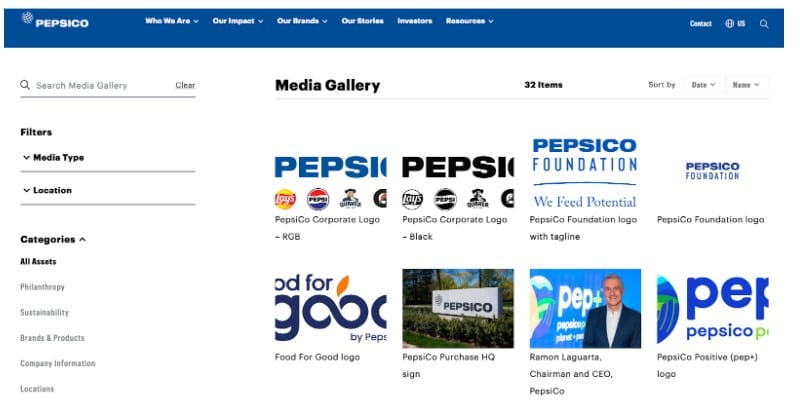It’s a business owner’s dream for a large publication to feature them in a news story. After all, who doesn’t want high-profile press?
This earned media can help bring more exposure and traffic to your brand. Plus, you get to build trust with your audience and build a strong brand reputation. Because if a reputable media company chooses to talk about your company, it must mean you’re doing something right.
The key to getting this exposure is doing something newsworthy. But apart from that, you also need a strong company press kit.
Here’s how to create an effective press kit that conveys your brand’s personality and makes it easy for websites, magazines, and publishers to tell your story in an authentic way.
Press kit essentials
In public relations, a press kit, or media kit, is a curated collection of materials that gives journalists everything they need to write about your brand, product, event, or team.
This helps media outlets streamline their work, as you’re providing them with relevant information in one place.
Focus on key elements like the program overview, student success stories, and accreditation. Make sure it’s visually appealing and reaches the right audience.
Include high-quality images and infographics and tailor the content to specific groups, such as those continuing to expand their career path.
A press kit often features essential documents that include:
- Press releases: A press release is your story in journalistic form. It’s the piece that breaks down your main message or announcement. This could include a product launch, a corporate milestone, or an event. Press releases are a valuable asset to include in your press kit. Nearly 70% of journalists rely on these stories to generate content ideas.
- Company overviews: This is a snapshot of your company. Think of it as the “elevator pitch” for media outlines. You’re introducing them to your brand, but without overselling. Your company overview should cover essential details like what you do, why you do it, and what sets you apart from the competition.
- Product or service information: If your press kit is for a specific product or service, provide all the information journalists will need. Include high-quality images, descriptions of features, and key benefits. Share what makes your product stand out. Add testimonials or case studies to back up your claims.
- Press coverage: If you’ve had media coverage before, include it in your press kit. This helps build credibility. Include links to articles, interviews, or even TV spots. You can also provide snippets or quotes that highlight positive coverage.
- Fact sheets: A fact sheet is a quick, no-frills reference guide that journalists use to get key details quickly. It’s a condensed version of the most important facts about your brand, product, or service. It should cover the basics like company history, mission, key statistics, product features, etc.
- Logos and photos: Journalists may need high-quality images and logos to illustrate a story. So, make sure they’re easy to access. Provide a variety of media formats, such as high-resolution photos, logos, and videos if relevant. Consider including visuals related to event photography to offer a broader range of appealing content. Name all files clearly (i.e., “Brand-Logo.jpg,” “Product-Image.jpg”).
- Contact information: Journalists may need to know who to reach out for follow-up questions, interviews, or additional materials. This includes phone numbers, addresses, and social media handles.
- Brand guidelines: Brand guidelines ensure that any content or materials you share with the media are consistent with your brand’s voice and identity. Include details on your brand’s tone, messaging, logo usage, typography, color palette, and other visual elements.
- Executive bios: The biography section highlights key people in your company, usually executives or any spokespeople. This helps journalists put a face to a brand and humanize your story. Include notable achievements and relevant background information,
To maintain a professional and polished presentation, it’s a good idea to prepare your files in universally accessible formats.
For instance, if you need to include signed agreements or consent forms, use online tools to make it simple to sign PDF documents digitally, making sure they’re secure and easily shareable with journalists or collaborators.
How to create an amazing press kit
Here’s a list of best practices to help you build a press kit that gives journalists accurate, up-to-date details to cover your story as you envision it.
1. Keep it organized
A press kit that’s easy to navigate ensures journalists can find specific information and for anyone else within your team to update it.
Organize it by sections and clearly label those sections, like PepsiCo does on its website.

If you’re providing a physical press kit, use a binder or folder with tabs. If it’s digital, use easy-to-navigate folders or create an online press kit that you host on your website.
2. Make it accessible
Journalists shouldn’t have to jump through hoops to find your press kit. Create a dedicated page on your websites where they can download all the necessary materials.
Include a simple URL that’s easy to share. If your press kit is for a major event, you can also set up a password-protected page for journalists to access exclusive content.
3. Keep it up-to-date
A press kit is a living document. As your brand grows, your products evolve, and your story changes. If you launch a new product, make sure it’s in your kit.
Have new press coverage? Update your fact sheet. Recently had a new executive join your team? Update their bio. Always check that your contact information is current, too. Journalists don’t want to waste time trying to call a number or use an email that’s no longer active.
4. Tailor it for your audience
Not all press kits are created equal. If your PR team is targeting specific industries or types of media outlets, customize your kit to fit.
For example, a press kit for a tech startup might focus on product specs and innovation. On the other hand, a lifestyle brand press kit might emphasize the brand’s ethos, visual appeal, and influencer partnerships.
Depending on your audience or industry, customize your press kit to speak directly to the kind of coverage you’re hoping to get.
Getting your brand press-ready
A press kit is your chance to control your brand’s story. If you do it right, it saves time and ensures your message is clear.
It will also help journalists understand who you are and what you stand for. Put in the effort now, and you’ll be ready to grab any media opportunity that comes your way.




